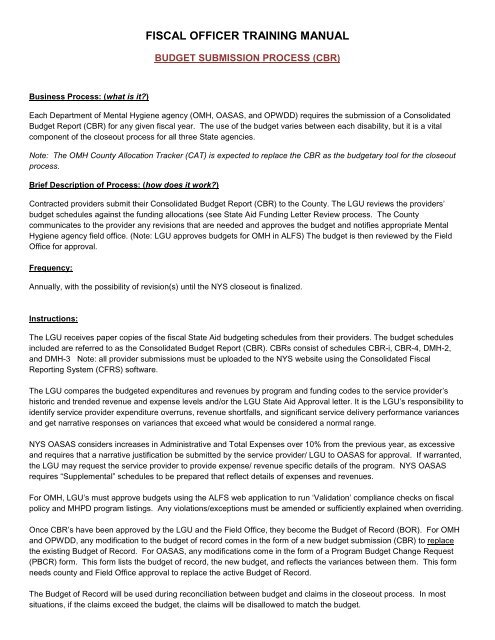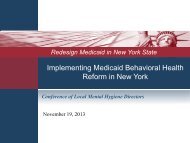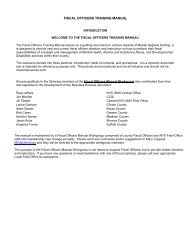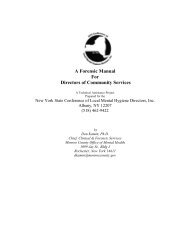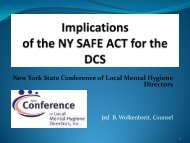CBR Submission Requirements
CBR Submission Requirements
CBR Submission Requirements
Create successful ePaper yourself
Turn your PDF publications into a flip-book with our unique Google optimized e-Paper software.
FISCAL OFFICER TRAINING MANUALBUDGET SUBMISSION PROCESS (<strong>CBR</strong>)Business Process: (what is it?)Each Department of Mental Hygiene agency (OMH, OASAS, and OPWDD) requires the submission of a ConsolidatedBudget Report (<strong>CBR</strong>) for any given fiscal year. The use of the budget varies between each disability, but it is a vitalcomponent of the closeout process for all three State agencies.Note: The OMH County Allocation Tracker (CAT) is expected to replace the <strong>CBR</strong> as the budgetary tool for the closeoutprocess.Brief Description of Process: (how does it work?)Contracted providers submit their Consolidated Budget Report (<strong>CBR</strong>) to the County. The LGU reviews the providers’budget schedules against the funding allocations (see State Aid Funding Letter Review process. The Countycommunicates to the provider any revisions that are needed and approves the budget and notifies appropriate MentalHygiene agency field office. (Note: LGU approves budgets for OMH in ALFS) The budget is then reviewed by the FieldOffice for approval.Frequency:Annually, with the possibility of revision(s) until the NYS closeout is finalized.Instructions:The LGU receives paper copies of the fiscal State Aid budgeting schedules from their providers. The budget schedulesincluded are referred to as the Consolidated Budget Report (<strong>CBR</strong>). <strong>CBR</strong>s consist of schedules <strong>CBR</strong>-i, <strong>CBR</strong>-4, DMH-2,and DMH-3 Note: all provider submissions must be uploaded to the NYS website using the Consolidated FiscalReporting System (CFRS) software.The LGU compares the budgeted expenditures and revenues by program and funding codes to the service provider’shistoric and trended revenue and expense levels and/or the LGU State Aid Approval letter. It is the LGU’s responsibility toidentify service provider expenditure overruns, revenue shortfalls, and significant service delivery performance variancesand get narrative responses on variances that exceed what would be considered a normal range.NYS OASAS considers increases in Administrative and Total Expenses over 10% from the previous year, as excessiveand requires that a narrative justification be submitted by the service provider/ LGU to OASAS for approval. If warranted,the LGU may request the service provider to provide expense/ revenue specific details of the program. NYS OASASrequires “Supplemental” schedules to be prepared that reflect details of expenses and revenues.For OMH, LGU’s must approve budgets using the ALFS web application to run ‘Validation’ compliance checks on fiscalpolicy and MHPD program listings. Any violations/exceptions must be amended or sufficiently explained when overriding.Once <strong>CBR</strong>’s have been approved by the LGU and the Field Office, they become the Budget of Record (BOR). For OMHand OPWDD, any modification to the budget of record comes in the form of a new budget submission (<strong>CBR</strong>) to replacethe existing Budget of Record. For OASAS, any modifications come in the form of a Program Budget Change Request(PBCR) form. This form lists the budget of record, the new budget, and reflects the variances between them. This formneeds county and Field Office approval to replace the active Budget of Record.The Budget of Record will be used during reconciliation between budget and claims in the closeout process. In mostsituations, if the claims exceed the budget, the claims will be disallowed to match the budget.
Note for OMH: Some programs (case management, residential, etc) must be budgeted according to specific fundingmodels. Additionally, programs that receive COPS, CSP, and DSH revenues must be budgeted to revenue thresholdsdefined by OMH. All programs must be budgeted according to the funding rules defined in the OMH Spending PlanGuidelines. See Case Management, COPS, CSP, and DSH procedures for information.Resources:1. Consolidated Budget Report manual:https://www.omh.state.ny.us/omhweb/cbr/manual.pdf#page=9https://www.omh.state.ny.us/omhweb/cbr/manual.pdf#page=92. Program Budget Change Request form: See Program Budget Change Request processDate: May 1, 2011OMH Review: 2/7/11OASAS Review: (none)OPWDD Review: (none)


